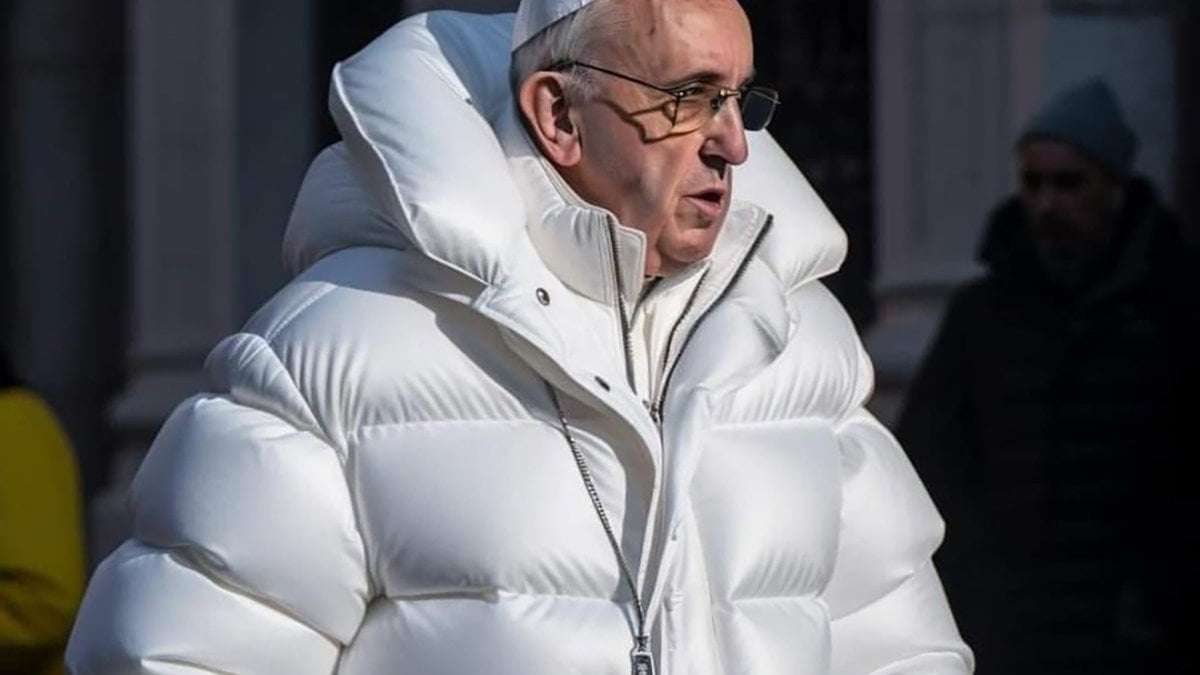A fake, AI-generated image of Pope Francis stepping out in a stylish white puffer jacket and bejewelled crucifix racked up millions of views over the weekend – with many mistaking it for a real image.
Experts fear the rapidly developing technology behind the image could soon undermine our ability to distinguish fake photos, which can be generated in seconds, from reality.
The AI program Midjourney was used to create the Pope image, which appears to have first been shared on a Reddit page dedicated to AI-generated art – before being reposted to Twitter, where a series of viral posts racked up millions of views while failing to disclose it wasn’t real.
It comes days after Eliot Higgins, founder of investigative journalism group Bellingcat, used Midjourney to generate vivid photos of former US president Donald Trump being arrested.
While he made clear they were created by an AI, other users copied the images and spread them without such attribution. Mr Higgins later said he had been banned from using the AI tool by its creators.
Making pictures of Trump getting arrested while waiting for Trump's arrest. pic.twitter.com/4D2QQfUpLZ — Eliot Higgins (@EliotHiggins) March 20, 2023
Midjourney is an AI-based technology that creates images from simple text prompts. While Photoshopping fake images has been possible for years, no skill is required to use the tool, which takes just seconds to generate photorealistic fakes. Other similar programmes include Open AI’s DALL-E and Stable Diffusion.
Henry Ajder, AI expert and presenter of the BBC radio series The Future Will be Synthesised, told i that this technology has developed with “lightning speed” within the last year, and shows no signs of slowing down.
Not only have the tools become “radically accessible” and easy for anyone to use, they have also become more sophisticated – generating images that look increasingly realistic.
“A lot of that image looks really good, especially at a first glance people might think the Pope is really adopting the Italian fashion sense.”
But Mr Adjer said there were still visible flaws that confirm the recent viral images as fakes, including the depiction of some body parts.
The AI image still has giveaway flaws (Photo:Twitter)
Examples are the Pope’s right hand, attempting to clutch a water bottle – which looks like a “glitchy mess”, or the blurry quality of Mr Trump’s wispy hair. The images can also have a hyper-real “plasticky” quality that points to something being off.
However, Mr Adjer said these inconsistencies could be ironed out within a space of months or years. It is possible that in one or two years, people will not be able to tell a real image from a fake one – even when scrutinising it closely.
So far, most users sharing AI art on Twitter are clearly flagging it and not intending to deceive. OpenAI and Midjourney are also working on safety restrictions on the prompts that people can enter to generate images, Mr Adjer said. But the trend is concerning, especially if the technology was used for malicious purposes and gets into the wrong hands.
He added: “Some of these images are already very, very hard to determine whether they are real or not. It gives us a sense of how bad actors, agents spreading disinformation, could weaponise these tools, particularly as some of the flaws in the current model start to be trained out and disappear.”
Dr Mhairi Aitken, ethics fellow at the Alan Turing Institute, told i that the images could be even riskier if used on everyday people and who do not have the resources to stop their spread.
They could be used to create fake, incriminating images to show people somewhere they shouldn’t be, or used as forms of bribery or humiliation – or on a larger scale to distort political processes.
Dr Aitken said one of the most worrying side effects was that these images could cause people to doubt the reality of true images that appear in traditional media outlets.
She said: “It could be images of the war in Ukraine, and if those are contested as being potentially fake, it significantly changes the narrative. That significantly changes what people believe to be true, and has implications for political positions and democratic processes.”
Even misinformation experts can be vulnerable. Dr Daniel Jolley, an assistant professor at the University of Nottingham who specialises in misinformation, admitted he did not realise the Pope photo was fake when scrolling through Twitter.
He said: “I genuinely laughed and thought what a weird thing for the Pope to wear, I didn’t even realise it was fake. The photo is of very good quality – and that is the danger of this type of misinformation, in that it looks so good.”
He said if images meet people’s prior beliefs, they are less likely to question them, because it “feels real” to them, while being repeatedly exposed to fake images and narratives can also convince people of ideas that are not true.

Tail_Nom on March 26th, 2023 at 19:44 UTC »
The problem here is that the stakes were extremely low for the pope picture. Specifically: I don't care. It never entered my mind to give a shit if the photo was real or not. That carries its own dangers, but ones which are different and less immediate than the other example of the AI-generated Trump arrest images.
OptimusSublime on March 26th, 2023 at 18:34 UTC »
Authorities say the phony Pope can be recognized by his puffy jacket, high top sneakers, and incredibly foul mouth
potatodog247 on March 26th, 2023 at 18:09 UTC »
I admit I fell for it because it did not seem outlandish to me.